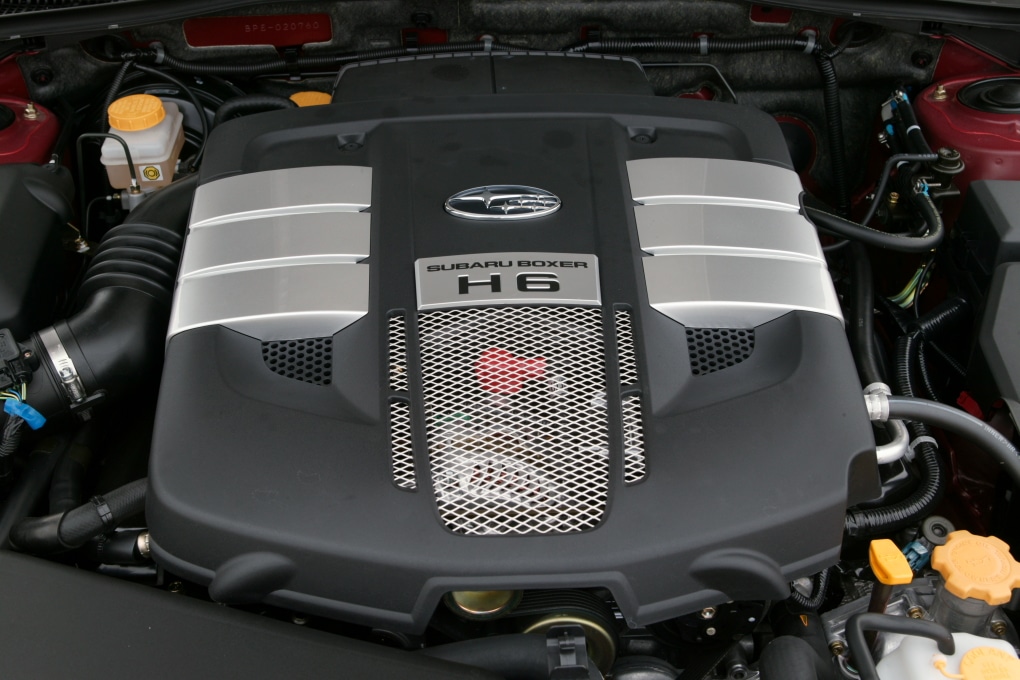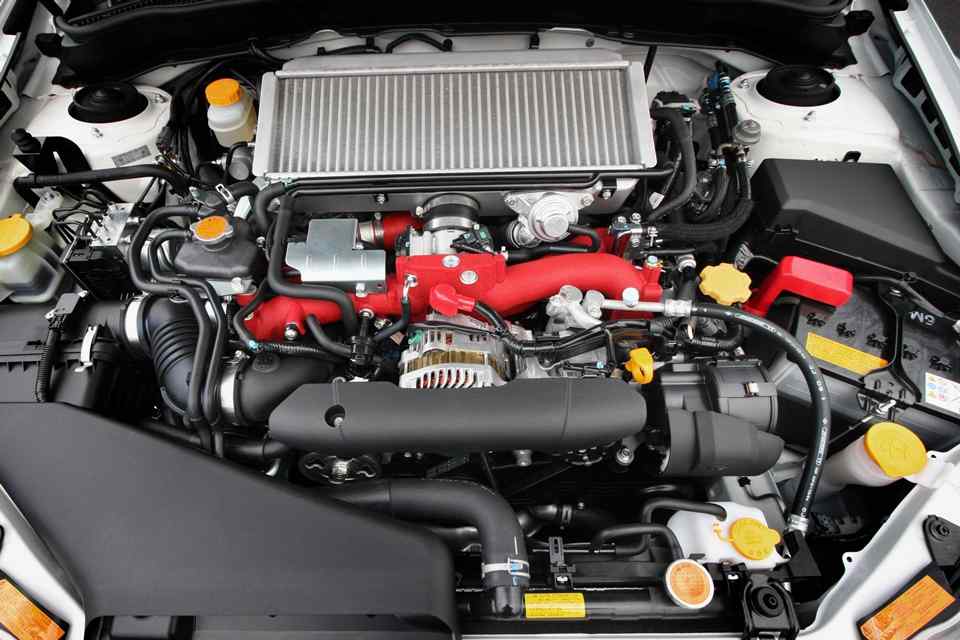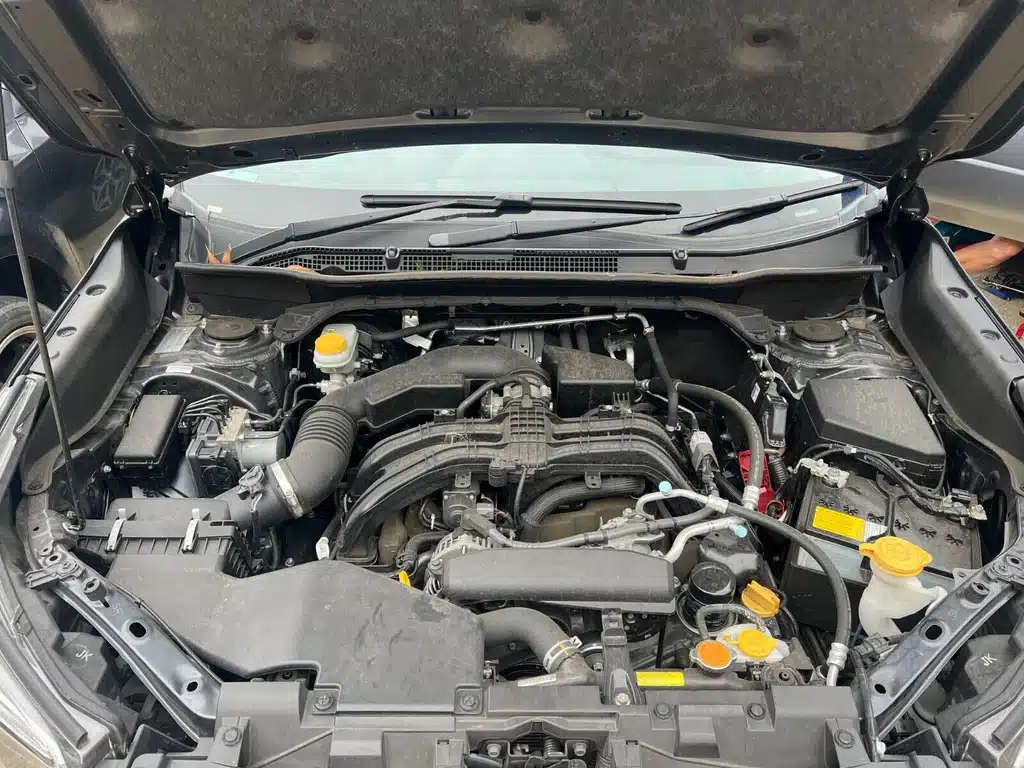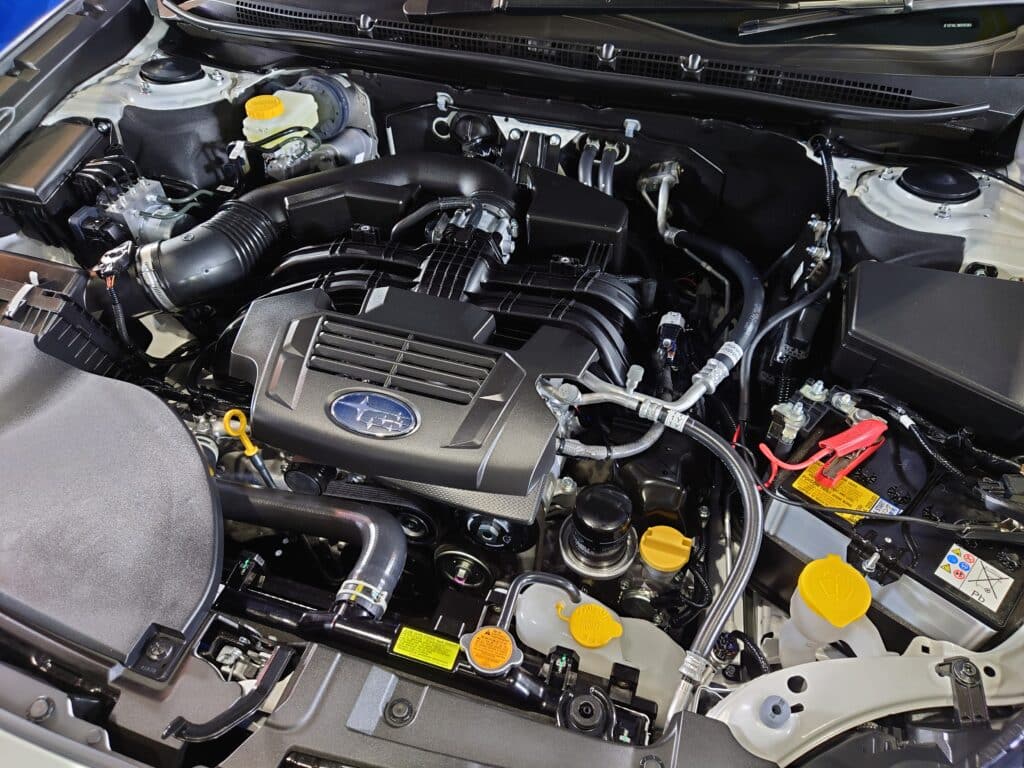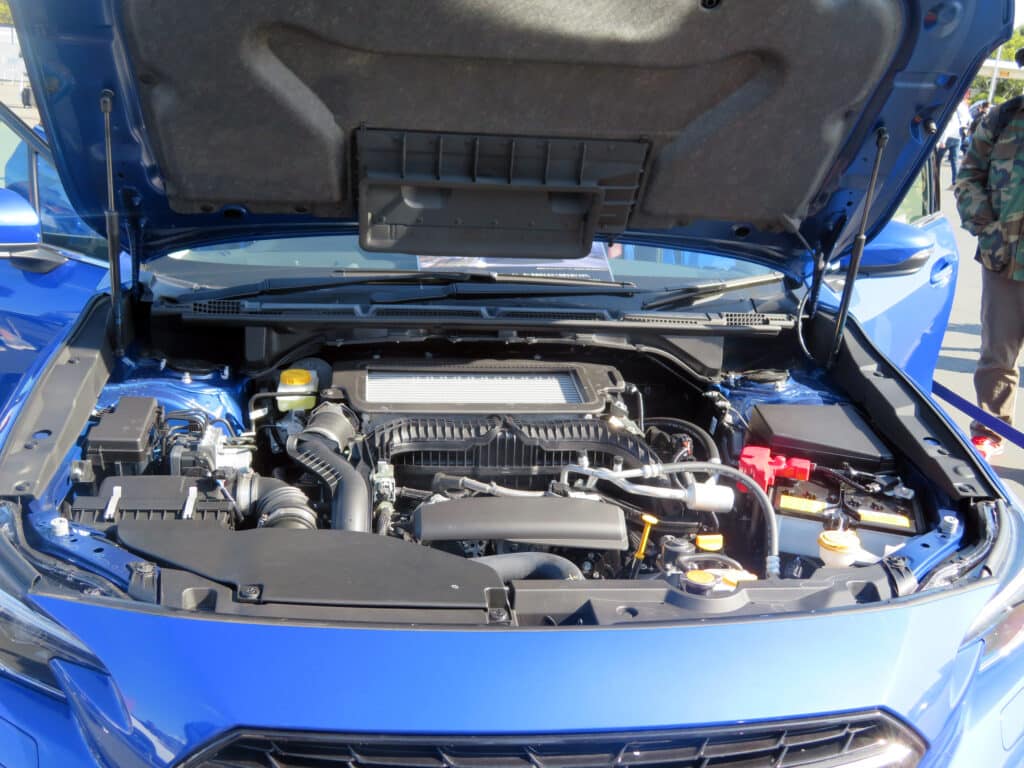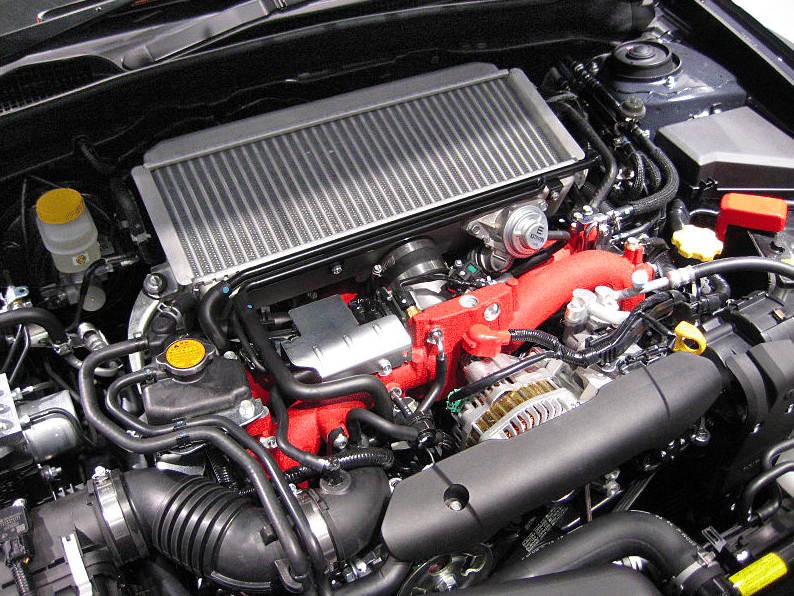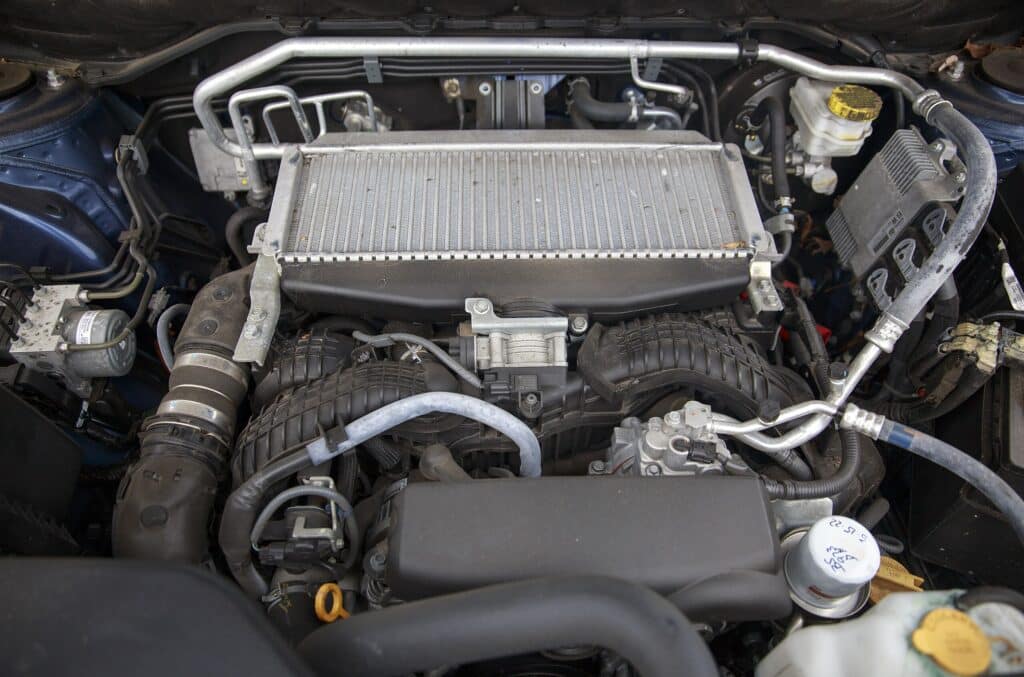
As I explore the pinnacle of engineering marvels in the automotive world, my attention zeroes in on the Subaru FA24F engine. This powerhouse is a testament to Subaru’s relentless pursuit of excellence, combining their iconic Subaru boxer engine layout with state-of-the-art turbocharged technology.
With the FA24F engine, Subaru has taken its repertoire of high-performance engines to new heights, offering car enthusiasts a perfect symphony of power and precision.
The leap from the faithful FA20DIT to the dynamic FA24F represents more than just an evolution—it signifies a revolution in Subaru’s performance offerings. The FA24F specs echo this sentiment; an aluminum block and head, direct injection, and the finesse of a twin-scroll turbocharger all come together to create an engine that not only excels in horsepower but also redefines what a Subaru turbocharged engine can be.
For those craving the exuberance of a Subaru direct-injection engine, the FA24F does not disappoint. It is, without doubt, a Subaru high-performance engine that stands as the heartbeat of machines like the 2022+ WRX.
Delving into the details, my focus sharpens on the numbers that gearheads revere. Subaru FA24F specs tout an impressive 260-271 horsepower and a 258-277 lb-ft torque range, depending on the model and tune. What’s clear is that the Subaru FA24F is not just another engine—it’s a symbol of the brand’s unyielding commitment to driving excitement.
Key Takeaways
- The Subaru FA24F engine is the next generation of Subaru’s performance-driven boxer engines.
- With turbocharged and direct-injection technology, efficiency meets power in this high-performance engine.
- FA24F specs underline significant improvements over its predecessor, offering more horsepower and refined torque delivery.
- Subaru has showcased its innovative engineering by adapting the FA24F across several models, including the esteemed 2022 WRX.
- Initial feedback on the FA24F engine points to a seamless blend of drivability and the raw excitement expected from a Subaru engine.
- Though the FA24F is a fresh face in the market, its roots in Subaru’s legacy of reliability and performance are evident.
- The FA24F engine’s design facilitates future tuning and enhancements, promising a new frontier for Subaru enthusiasts.
Evolution of Performance: The Subaru FA24F Story
The timeline of Subaru’s engine innovation took a remarkable leap forward with the advent of the FA24F engine. As I unravel this chapter in the storied history of Subaru’s engineering, it’s imperative to recognize that this is not merely about enhanced power but a transformative vision for performance engines.
The emergence of the FA24F engine evolution marked a pivotal moment, steering away from the previous FA20DIT and delivering a much-anticipated turbocharged 2.4L powerplant.
Since its introduction in the 2019 Subaru Ascent, the FA24F engine has churned considerable interest among car enthusiasts. It wasn’t just a larger displacement that made waves but the intuitive synthesis of proven technologies and new upgrades.
This new Subaru engine upgrades commitment promised a higher power output, exploiting the robust architecture of direct injection technology that defined the older FA20DIT. Consequently, the Subaru community buzzed with anticipation—how would this engine redefine the Subaru FA24F performance history?
With the discontinuation of the WRX STI, the WRX equipped with the FA24F engine ascended as the new performance bastion for Subaru. I comprehended that the FA24F engine’s destiny was not merely to fill the void but to elevate Subaru’s performance lineage to greater heights. As I reflect on the 2022 Subaru WRX engine, it embodies Subaru’s ingenious solution to contemporary demands for more power married with efficiency.
Finally, the FA20DIT from 2015 was getting a serious upgrade—Subaru enthusiasts rejoiced at the announcement of the inclusion of the FA24F engine in the new 2022 WRX, heralding a new era in performance.
- Subaru Ascent – Introduction of the turbocharged FA24F engine
- Outback and Legacy XT models – Implementation of FA24F showcases versatility
- 2022 WRX – The FA24F breathes new life into Subaru’s performance icon
- Naturally Aspirated FA24 – A fresh take with the Subaru BRZ
Embracing the Subaru FA24F history is more than acknowledging numbers—it’s appreciating the journey of a powertrain from its nascent stages to becoming the heart of some of the most compelling vehicles in the market.
Through testing, refinement, and real-world application, Subaru has ensured that its latest engine continues its legacy of performance and sets the benchmark for future innovations.
| Specs | FA24DIT (Turbocharged) | FA24D (Naturally Aspirated) |
|---|---|---|
| Displacement | 2.4L (2,387 cc) | 2.4L (2,387 cc) |
| Configuration | 16 Valve Flat 4 | 16 Valve Flat 4 |
| Aspiration | Twin-Scroll Turbo | Naturally Aspirated |
| Bore & Stroke | 94mm X 86mm | 94mm x 86mm |
| Fuel System | Direct Injection | Direct Injection with Port Injection (Toyota D-4S) |
| Horsepower Output | 260-271 hp | 228-234 hp |
| Torque Output | 258-277 lb-ft-tq | 184 lb-ft-tq |
The emerging tableau is not simply one of data points but a vivid narrative of a boxer engine’s metamorphosis. This FA24F engine evolution becomes all the more gripping when one considers the nuanced calibration that goes into optimizing these engines for various vehicle applications—this is where Subaru’s prowess truly shines through.
The Heart of a Rally Champion: FA24F Engine Specifications
Delving into the heart of Subaru’s rally-inspired prowess, I discovered the essence of what makes the FA24F a high-performance Subaru engine par excellence. With its introduction, the FA24F specs positioned it as a natural heir to the throne once occupied by the admired FA20DIT—a turbocharged marvel that defined an era.
Subaru’s Quest for Efficiency and Power
My exploration led me to the core of the Subaru FA24F engine, where efficiency and power converge. I found a meticulously designed 2.4L displacement unit that elegantly balances robust performance with the rigors of efficiency.
Beneath its aluminum exterior, the engine operates with a 10.6:1 compression ratio, harmonizing twin-scroll turbocharging and Subaru direct injection to ensure FA24F power and efficiency and deliver the response that a Subaru rally engine should embody.
Direct Injection and Turbocharging: A High-Performance Duo
As I further examined the inner workings of the FA24F engine, it became apparent that the incorporation of gasoline direct injection benefits was a decisive factor in its enhanced performance. The FA24F fuel system operates under immense pressure, reaching up to 2,000-3,000 PSI—far surpassing traditional fuel systems.
This technical marvel allows for precise fuel delivery, leading to an unparalleled engine response and a transparent delivery curve—a role fulfilled by few and envied by many.
FA24F vs FA20DIT: The Technical Advancements
Putting the FA24F and the FA20DIT side by side, I unearthed the substantial evolutionary steps that Subaru took with its engine advancements.
From a bigger bore, which leapt from the FA20DIT’s 86mm to 94mm in the FA24F, to improvements in the turbocharger design and fuel delivery, it was clear that Subaru was not just making incremental steps, but significant strides in engine development.
These FA24F technical improvements result in a powertrain with more horsepower, increased torque, and a smoother power band, setting a benchmark for future Subaru engine models.
As a testament to Subaru’s innovative journey, here’s a comparative glimpse into the FA24F and its forerunner:
| Aspect | FA20DIT (Previous Generation) | FA24F (Current Generation) |
|---|---|---|
| Displacement | 2.0L | 2.4L |
| Bore | 86mm | 94mm |
| Turbocharger | Single-scroll | Twin-scroll |
| Direct Injection | Yes | Yes, with enhanced system |
| Horsepower | 268-296 hp | 260-271 hp |
| Torque | 258 lb-ft | 258-277 lb-ft |
As I probed the FA24F’s credentials, the Subaru engine’s saga of technical brilliance was evident. The table above doesn’t just recount the advancements from the FA20DIT comparison—a testimony in itself—it paints a broader picture of a legacy in progress. Aspiring to satisfy the demands of a modern, knowledgeable base of Subaru enthusiasts, the FA24F champions their quest for pure, unadulterated performance.
“Subaru engineers envisioned a turbocharged heartbeat that could withstand the rigors of the untamed wilderness and the precision of asphalt—hence the FA24F was born, a masterpiece crafted in the forges of efficiency and exhilarating power.”
Built to Last: Analyzing the FA24F’s Durability and Reliability
My inquiry into the FA24F reliability uncovers a landscape where innovation melds with dependability, framing a narrative about an engine poised for longevity. In the umbral shadows of the nascent FA24F engine, I’ve engaged with the collective insights surrounding its Subaru engine lifespan, seeking to discern its ability to withstand the test of time.
Subaru, renowned for its steadfast engines, has crafted a new legend in the FA24F with anticipation for an enduring performance that resonates with the brand’s legacy of Subaru Boxer engine reliability.
Reflected by enhanced FA24F engine durability, key advancements emerge through meticulous design choices. Upgraded from its precursor—the celebrated FA20DIT—the FA24F touts internal fortifications like fortified piston design and robust connecting rods. These are not merely incremental modifications but revolutionary reconfigurations, aspiring to protract the FA24F engine lifespan even as it embarks upon a journey filled with high-performance thrills.
Despite its relative youth, Subaru’s undeterred emphasis on quality primes the FA24F for a future less encumbered by FA24F engine problems. Moreover, with direct injection refinements and integrating a high-pressure fuel pump, the FA24F is engineered to surmount erstwhile vulnerabilities, endorsing its stature as a paragon of performance and durability.
“Where the FA20DIT laid a foundation of innovation, the FA24F erects a monument to endurance, manifesting Subaru’s unwavering commitment to reliability in an engine that beckons the ambitious and reassures the prudent.”
The naturally aspirated compatriot, the FA24D, brandishing similar improvements tailored to its non-turbocharged embodiment, also hints at a future where reliability is paramount. Albeit real-world data is still congregating, the prospects of the FA24D align with the high standards habitually met by Subaru engines.
Encapsulated in the table below are the advancements with a potential impact on the FA24F’s durability and reliability:
| Advancement Feature | Description | Expected Impact on Durability |
|---|---|---|
| Upgraded Piston Design | Enhanced pistons built to reduce wear and handle higher pressures. | Designed for longevity despite the rigors of increased pressure rates. |
| Robust Connecting Rods | Strengthened rods to support greater torque and horsepower. | Alleviates past incidences of rod failure, especially under boosted conditions. |
| Improved Direct Injection System | Refined fueling for more precise combustion control. | Contributes to overall engine health through better fuel economy and emission standards. |
| High-Pressure Fuel Pump | Capable of sustaining the higher fuel demands of a turbocharged engine. | Designed for longevity, despite the rigors of increased pressure rates. |
| Oil Cooler Incorporation | Maintains optimal oil temperatures under performance driving. | Preserves engine life by mitigating overheating risks. |
As my analysis cogitates these enhancements, it’s evident that Subaru is steering the FA24F towards a future of remarkable performance and staunch reliability that bears the hallmark of Subaru innovation. The fabric of this engine’s storied existence promises a continuum of excitement and assurance for drivers around the globe.
Maximizing the FA24F’s Potential: Performance Tuning and Upgrades
As I delve into the realm of performance tuning, the prospect of FA24F performance tuning ignites a sense of excitement. The engine’s inherent responsiveness and lower boost pressure lay a foundation ripe for exploration. The Subaru engine upgrades and aftermarket support for this powerplant are still in their infancy.
Nonetheless, the demonstrated ability of tuned FA24F engines, like the one in the notable Prime Motoring Crosstrek project, suggests a robust Subaru tuning potential waiting to be tapped into.
Understanding the nuances of the FA24F design is integral to realizing its modding potential. The stock configuration’s conservative tuning may have some Subaru enthusiasts yearning for a spike in power. Yet, within its aluminum confines lay the makings of something spectacular.
The FA24F modding trajectory, though yet to be fully charted, is predicted to soar, with the engine proving its capability to handle significant enhancements without forgoing its reliability. Major performance enhancement projects are likely to surface as the car’s presence matures in the market.
Capable of over 500whp while retaining the stock block is a testament to the formidable Subaru performance enhancements scope for the FA24F. Harnessing such potential wisely ensures that we can push the boundaries of performance while keeping within the structural integrity of what’s provided by Subaru. I’m poised to witness how this narrative unfolds as the FA24F will become a beacon of modding potential for Subaru enthusiasts and tuners worldwide.
FAQ
What is the Subaru FA24F engine?
The Subaru FA24F engine is a 2.4L turbocharged direct-injection flat-four boxer engine. Introduced in the 2019 Subaru Ascent, it delivers high performance and efficiency, suitable for modern rally-inspired vehicles.
What makes the FA24F engine different from its predecessors?
The FA24F engine offers a larger displacement than the FA20DIT (2.4L vs. 2.0L), increased horsepower and torque, an aluminum block and head, as well as utilizing a twin-scroll turbocharger and gasoline direct injection for improved performance and efficiency.
What are the power and torque specifications of the FA24F engine?
The Subaru FA24F engine produces between 260-271 horsepower and 258-277 lb-ft of torque, varying slightly depending on the model it’s used in.
What type of forced induction does the FA24F engine use?
The FA24F engine uses a twin-scroll turbocharger, providing better power output and improved efficiency across the engine’s power band.
Does the FA24F engine have a timing belt or a chain?
The Subaru FA24F engine utilizes a timing chain rather than a belt, which typically requires less frequent maintenance and is generally considered more durable.
Is the FA24F an interference engine?
Yes, the FA24F is an interference engine, which means that if the timing chain were to fail, there is a risk of the valves and pistons colliding, possibly causing significant engine damage.
What are common problems with the FA24F engine?
As a newer engine, the FA24F has not been associated with widespread issues; however, like any engine, it requires proper maintenance to prevent potential problems. Owners should be vigilant of the high-pressure fuel systems and turbocharger components, which are complex and potentially problematic areas.
How reliable is the FA24F engine?
The FA24F engine is designed with reliability in mind, incorporating stronger internal components than the FA20DIT. While long-term reliability is yet to be fully established due to its relative newness, early indications suggest improved durability.
What is the oil capacity of the FA24F engine?
The oil capacity for the FA24F engine is typically around 5.1 US quarts (including the filter), but always reference the owner’s manual for the specific model for accurate information.
Read Also: Subaru Outback oil capacity
What weight is the FA24F engine?
Subaru does not publish the exact weight of the FA24F engine, but boxer engines are generally heavier than in-line engines due to their construction and layout.
Can you modify the FA24F engine for more power?
Yes, the FA24F engine has good potential for performance tuning and upgrades. The aftermarket community has started to develop solutions for increasing power output significantly while maintaining reliability.


